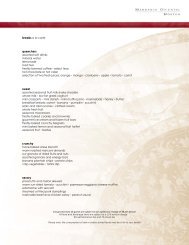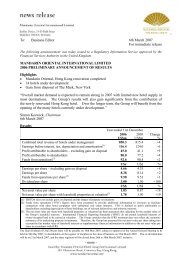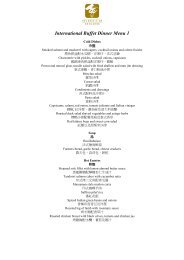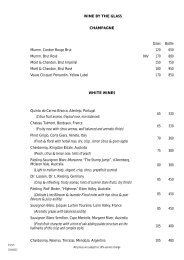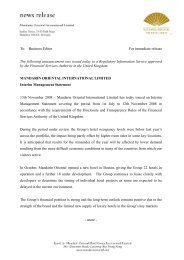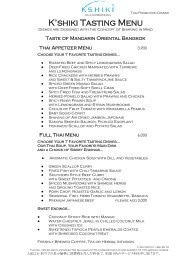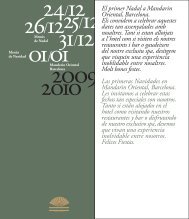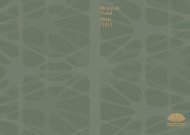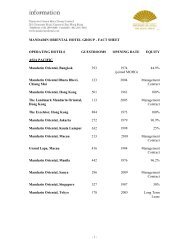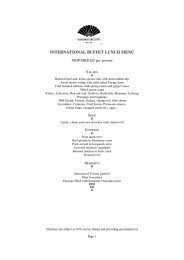Annual Report 2011 - Mandarin Oriental Hotel Group
Annual Report 2011 - Mandarin Oriental Hotel Group
Annual Report 2011 - Mandarin Oriental Hotel Group
Create successful ePaper yourself
Turn your PDF publications into a flip-book with our unique Google optimized e-Paper software.
32 <strong>Mandarin</strong> <strong>Oriental</strong> International Limited<br />
Principal Accounting Policies Continued<br />
A Basis of preparation continued<br />
Standards and amendments effective after <strong>2011</strong> which are relevant to the <strong>Group</strong>’s operations and<br />
yet to be adopted<br />
Amendments to IFRS 7 Financial Instruments: Disclosures on Derecognition<br />
IFRS 9 Financial Instruments<br />
IFRS 10 Consolidated Financial Statements<br />
IFRS 11 Joint Arrangements<br />
IFRS 12 Disclosure of Interests in Other Entities<br />
IFRS 13 Fair Value Measurement<br />
Amendments to IAS 1 Presentation of Items of Other Comprehensive Income<br />
IAS 19 (amended <strong>2011</strong>) Employee Benefits<br />
IAS 27 (<strong>2011</strong>) Separate Financial Statements<br />
IAS 28 (<strong>2011</strong>) Investments in Associates and Joint Ventures<br />
Amendments to IFRS 7 ‘Financial Instruments: Disclosures on Derecognition’ (effective for annual period beginning<br />
1st July <strong>2011</strong>) promotes transparency in the reporting of transfer transactions and improves users’ understanding of<br />
the risk exposures relating to transfer of financial assets and the effect of those risks on an entity’s financial position<br />
particularly those involving securitization of financial assets.<br />
IFRS 9 ‘Financial Instruments’ (effective from 1st January 2015) is the first standard issued as part of a wider<br />
project to replace IAS 39. IFRS 9 retains but simplifies the mixed measurement model and establishes two primary<br />
measurement categories for financial assets: amortized cost and fair value. The basis of classification depends on the<br />
entity’s business model and the contractual cash flow characteristics of the financial asset. IFRS 9 is likely to affect the<br />
<strong>Group</strong>’s accounting for its financial assets. The <strong>Group</strong> has yet to assess the full impact of IFRS 9 and will apply the<br />
standard from 1st January 2015.<br />
IFRS 10 ‘Consolidated Financial Statements’ (effective 1st January 2013) replaces SIC Interpretation 12<br />
‘Consolidation – Special Purpose Entities’ and most of IAS 27 ‘Consolidated and Separate Financial Statements’.<br />
It contains a new single consolidation model that identifies control as the basis for consolidation for all types of entities.<br />
It provides a definition of control that comprises the elements of power over an investee; exposure of rights to variable<br />
returns from an investees; and ability to use power to affect the reporting entity’s returns. The <strong>Group</strong> has yet to assess<br />
the full impact of IFRS 10 and will apply the standard from 1st January 2013.<br />
IFRS 11 ‘Joint Arrangements’ (effective 1st January 2013) replaces IAS 31 ‘Interests in Joint Ventures’ and classifies<br />
joint arrangements as either joint operations (whereby the parties that have joint control have rights to the assets and<br />
obligations for the liabilities of the joint arrangements) or joint ventures (whereby the parties that have joint control<br />
have rights to the net assets of the joint arrangements). It prescribes the accounting for interests in joint operations<br />
as its interest in the assets, liabilities, revenues and expenses. The current option permitted by IAS 28 (amended) to<br />
proportionately consolidate for joint ventures is no longer permitted. The <strong>Group</strong> has yet to assess the full impact of<br />
IFRS 11 and will apply the standard from 1st January 2013.



